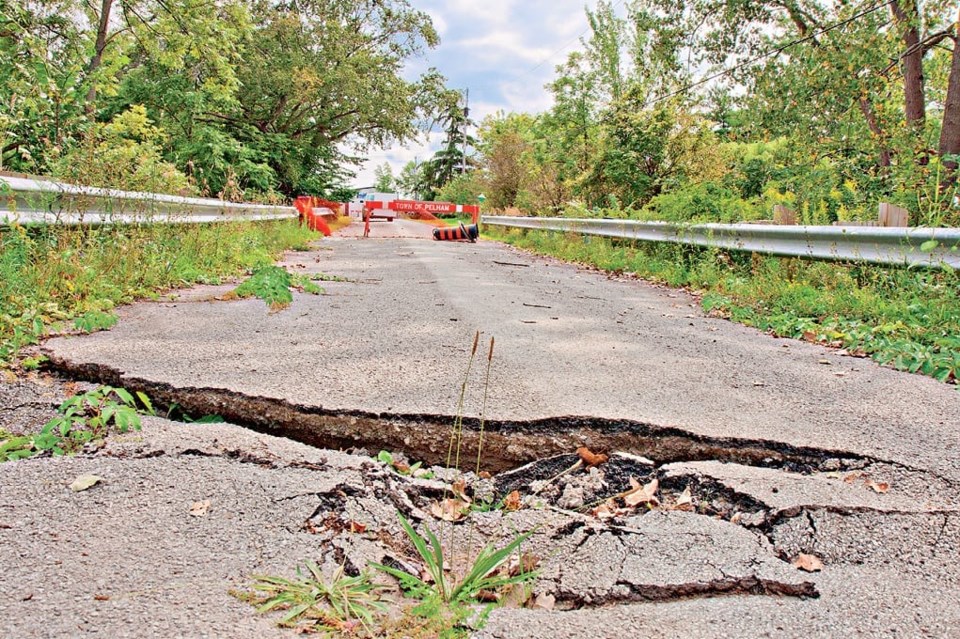$1.2 million price tag for a culvert may make it a bridge too far
The saga of the Poth Street culvert, the collapse of which earlier this year has led to an eight-month closure of the road, continued during the last Council meeting.
In August, Council voted to commission further drilling beneath the culvert, drilling which attempted to find solid ground that could support footings.
Last Monday, Town Director of Public Works Andrea Clemencio provided Council with a report that recommended the consideration of $1.2 million in the 2018 budget to cover the cost of replacing the structure. The cheapest proposed solution is a steel bridge, plate-box culvert on footings and piles. Engineers who consulted on the project were in attendance, and they moved to the podium to answer questions.
Councillor Richard Rybiak was the first to speak. “I’m not one to second-guess professionals,” he said. “So I’m reluctant to demonstrate my lack of expertise. I understand that there is fear that in replacing existing culverts with the same ones there is a danger that they’d sink two hundred and fifty millimetres, bringing worries about maintenance. But the culvert did not sink before—it needs to be replaced not because it sunk, but because the material had rusted and rotted away.”
One of the engineers, Jack Turner, responded. “The design life of those pipe arch culverts is fifty years, and these ones prematurely failed after forty years. New ones wouldn’t sink automatically. It would happen over time.”
Turner added that the existing culverts “likely failed from a combination of factors,” and that he didn’t recommend putting back the same type of support.
When the issue was discussed in August, former Councillor Marvin Junkin had expressed incredulity that such extensive geotechnical study was necessary. On Monday night, two hours after Junkin’s resignation, Rybiak echoed Junkin’s concerns, saying that it was unlikely that geotechnical surveys were done when the old culverts were installed 40 years ago.
After being prompted by Mayor Augustyn, Clemencio told Rybiak that replacing the culverts with the same style would cost in the neighbourhood of $618,000, leading Rybiak to suggest that for a shorter lifespan this was not really an economic alternative.
“The bigger element is the risk factor,” said Clemencio. “We couldn’t recommend putting something back the same as before. It wouldn’t meet federal requirements.”
Councillor Gary Accursi was the next to take a swing at the $1.2 million proposed cost.
“Did this soil change from the time of the original culverts?” he asked the engineers. Geotechnical engineer Michael Patterson stepped forward to answer.
“The soil definitely is not changed,” said Patterson. “That process takes thousands and thousands of years. I am not aware of any geotechnical investigation being done back in the Seventies.” Patterson explained that the soil underneath the Poth Street culvert is very soft, and that drilling went 100 feet down in order to find solid ground.
There were several residents on Poth in the audience, and at this point, one of them raised his hand. “Can I ask a question?” he said. Augustyn, who was chairing the meeting, hesitated before he spoke.
“I…don’t think so,” he said. “Unless Council would like to allow it?” he looked around the table, and Councillors shook their heads negatively. “But we can makes sure that the engineers are accessible afterwards.”
Augustyn then questioned the engineers, asking if all other options had been considered. “Is it possible to float concrete there? I know that Chicago, for example, is built on floats.”
Patterson replied that such floats were typically only suitable for unmoving constructions, as opposed to a bridge over which traffic flows.
Rybiak who had opened discussion, was the last to speak. “If it’s $1.2 million and there’s no alternative, then I guess it’s the only option. I always say that decisions are easy if there are no options. We’ll have to decide whether we’ll do it at all.”
Council voted to accept Clemencio’s recommendation to consider the matter for the 2018 budget.



